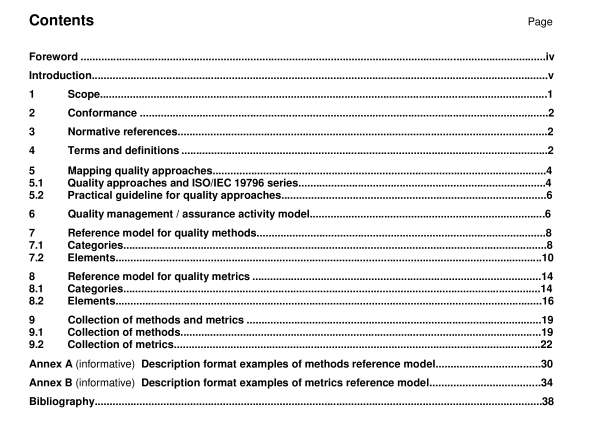BS ISO IEC 19796-3 pdf – Information technology – Learning, education and training – Quality management, assurances and metrics

BS ISO IEC 19796-3 pdf – Information technology – Learning, education and training – Quality management, assurances and metrics
1 Scope This part of ISO/IEC 1 9796 extends the ―reference framework for the description of quality approaches‖ (RFDQ) defined in ISO/IEC 1 9796-1 by providing a harmonized description of the methods and metrics required to implement quality management and quality assurance systems for stakeholders designing, developing, or utilizing information technology systems used for learning, education, and training.
Activities such as quality planning, quality control, and quality improvement are important for quality management implementations. While these three activities are focused on products, processes and their development, quality assurance is focused more on confirmation and indication for internal and external stakeholders. It should be noted that the reference methods and metrics for this part of ISO/IEC 1 9796 include issues related to the implementation of quality management and assurance systems for information technologies that are used for learning, education, and training. This part of ISO/IEC 1 9796 is to be used to help identify methods and metrics to implement a quality assurance and management system of an IT system used for learning, education, and training. For example, it may be used for quality management systems that help to verify items such as IT system effectiveness, compliance with quality objectives including purposes, customer satisfaction, training in the use of the IT system, complaints handling, and auditing. m NOTE While not included in the normative references of this part of ISO/IEC 19796 it may be helpful for ITLET (Information Technology for Learning, Education, and Training) stakeholders interested in quality issues to refer to the related standards listed in the bibliography for further information regarding quality management and quality assurance.
During the implementation of quality management and quality assurance systems, using specific methods and metrics are indispensable for the exchange, purchase, management, and archiving of learning courses, systems, and/or services. Involving all stakeholders (e.g., developers, administrators, government, providers, teachers, and learners) within a framework that is open and inclusive will help to ensure that information technologies for learning, education, and training are both effective for and appropriate to learning and teaching needs. This part of ISO/IEC 1 9796 has the following components, which are developed in order to indicate and communicate quality approaches.
• The reference model for methods — provides an interoperable formalized description of methods that can be easily implemented and adopted into a quality management system to realize and facilitate quality management.
• The reference model for metrics — provides an interoperable formalized description of metrics that can be easily implemented and adopted into a quality management system to measure quality in a comparable way.
• A collection of methods that can be used to manage and assure quality in different contexts. It supports stakeholders to implement concrete actions to achieve (a set of) quality objectives.
• A collection of metrics and indicators that can be used to measure quality in processes, products, components, and services. It supports stakeholders to implement measures (e.g. indicators) for specific quality objectives.
• Annex A (informative) contains examples of how this part of ISO/IEC 1 9796 can be used and provides a suggested format to describe a quality method.
• Annex B (informative) contains examples of how this part of ISO/IEC 1 9796 can be used and provides a suggested format to describe a quality metric. 2 Conformance The objective of this part of ISO/IEC 1 9796 is to extend the RFDQ (defined by ISO/IEC 1 9796-1 ) leading to a complete quality system that supports stakeholders to implement quality management and quality assurance systems. For each quality management and assurance process a set of potential methods and metrics that can be used at the development of individual quality approaches needs to be specified. The harmonized description of these methods and metrics is needed to provide clear understanding, mutual communication and agreement. The collections of methods and metrics such as quality approaches should be extensible. A method or metric is conformant if it uses the corresponding reference model (i.e. Clause 7 for methods and Clause 8 for metrics) or an instantiation in description format (as noted in Table 1 for methods and Table 2 for metrics). A conforming description may contain descriptions of processes or approaches in addition to what is included in this part of ISO/IEC 1 9796. In other words, it is intended to be extensible and may contain additional data elements. If it exists in the reference methods or metrics collection then a reference should be provided to facilitate verification that it is conformant.









